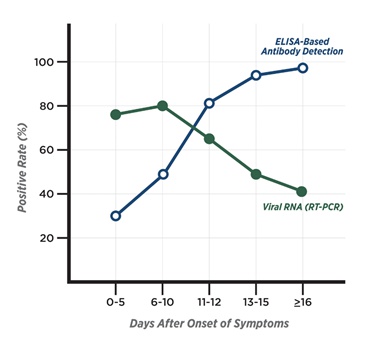Quantitative Viral Serology
Recent studies have shown that the false negative rate (a negative test result for a
patient with COVID-19) range from 2% to as high as 37%. If the virus testing is
performed after 8-10 days from the onset of symptoms, a dramatic drop-off in
positivity (a positive test result) is observed and false negative rates increase
dramatically (see figure1 below).
MLO: Stanley J. Naides, MD, FAP, FACRMaite Sabalza, Ph.D.Iswariya Venkataraman, PhD Jun 24th, 2020
IgG antibodies (part of our body's immune system) can be detected in COVID-19 as
early as the first week of illness onset. Optimally, IgG antibody to specific COVID-19
markers (see COVID-19 structure below) should be performed after 2 weeks from
onset of symptoms or your last vaccination (4 weeks after J&J) so that levels are easily
measured. The presence of antibody indicates the patient has been infected or
vaccinated. (Note: there are instances when a patient has been infected or vaccinated
but does not produce detectable antibodies). These tests represent a tool to for the
physician to confirm whether the initial negative virus test was truly negative or a false
negative (an infected patient testing negative) and it can identify responses to
vaccination.
2-Confirming whether a negative COVID-19 test is a true negative
Allermetrix antibody testing involves IgG that is directed against the N-protein
(nucleocapsid), S1-protein (spike subcomponent) and the RBD (receptor binding
domain)
figure 1




